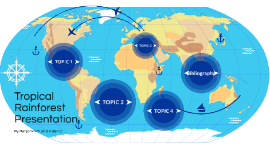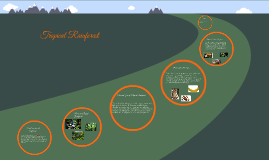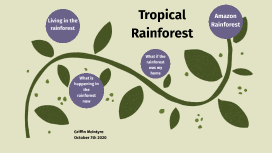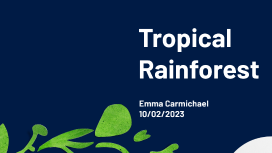Tropical Rainforest Presentation
Transcript: By Benjamin M. and Aiden C. Tropical Rainforest Presentation TOPIC 1 Geography What does it look like? SUBTOPIC 1 The rainforest is a very hot and humid area. The area is very dense with vegetation, which prevents most sunlight from reaching the ground. TIMELINE May 7-15 Barcelona What is the climate like? SUBTOPIC 2 The climate tends to stay the same all year, the temperature being about 70-90 F. As well, the humidity is on average 77-88% all year, and it can rain 100-400 inches annually. CHARTS CHARTS PICTURES PICTURES Living Things TOPIC 2 Plants The rainforest is known to contain about 50% of Earth's plants and animals. As well, 70% of plants known to help in cancer treatment are found solely in the rainforest. Some examples of plants that are found in the rainforest would be more well-known ones, such as cacao, which is found in chocolate, and orchids, which are considered to be some of the most beautiful flowers found in nature. Some others you may not have known about are the monkey brush vine, which is a parasitic plant that provides a feeding place for hummingbirds, and the rubber tree, which as shown in the name, is known for helping to process rubber. TOPIC 1 Pictures Photos Rubber Tree Orchid Cacao Monkey Brush Vine Animals The tropical rainforest is known to have about 10% of all known animal species on the planet. Some examples would be the predators, being the jaguar, which is the pinnacle predator in the tropical rainforest, and the boa constrictor, which is an enormous snake that uses camouflage to hide and seek out its prey. One other animal found in the rainforest is the poison dart frog, which is only actually deadly in three species. They have vibrant colors in order to keep away the predators. As well, there is the keel-billed toucan, which lives in holes in trees, and given the little room they have, they must tuck their beaks under their bodies in order to conserve space. TOPIC 2 Photos Photos Boa Constrictor Poison Dart Frog Keel-Billed Toucan Jaguar Adaptations One thing animals have needed to do in order to survive is to try and create camouflage, which helps them with hunting for prey as well as hiding from predators. Another thing that is necessary they do is evolve and change their size, because there isn't much room in the rainforest. One last thing that is essential to their survival is become nocturnal, because that helps the predators to find their prey. TOPIC 3 Dangers and Conservation TOPIC 3 Dangers One danger in the tropical rainforest is the high chance of catching a disease. Another danger that is in the tropical rainforest is the wildlife, and there are many predators within. Finally, the weather creates a large risk, because when it rains, it rains heavily, which can cause the rivers to overflow. TOPIC 1 Conservation Efforts When the lumber and the minerals are harvested in the tropical rainforest, this causes them to begin disappearing. according to the book "Rain Forest Destruction", since 1990 in Central America, the tropical rainforests have declined by 18.9%. As well, according to Mongabay, large-scale agriculture has been the cause of over 80% of rainforest demolition. But what can we do to stop this? TOPIC 2 What can we do to stop the destruction of rainforests? One thing we can do to put an end to the leveling of the rainforests is to establish more parks and reserves. Another thing we could do to stop this is replant the trees that we have already cut down. We could also try encouraging the logging companies to act in such a manner that they harm the tropical rainforests much less. TOPIC 1 Charts Charts Activities One thing you can do in the tropical rainforest is take photos of the wildlife. Be careful when you are doing this, as some of the wildlife can be dangerous. Smile! A second activity you can preform while you are in the tropical rainforest is fishing for piranhas. I know this may seem a bit dangerous, but it is a very common activity. Another fun thing to do while you are in the rainforest is kayaking. If you aren't experienced, I would recommend not going without a professional. One final thing to have fun doing in the rainforest is to visit the worlds many beautiful national parks. These are reserved places, where they cannot legally damage the rainforests. TOPIC 4 Bibliography -McLeish, Ewan. Rain forest destruction. Milwaukee, WI: World Almanac Library, 2007. -The World Book Encyclopedia 2012. World Book, Inc., 2012. -"Top 10 Amazon River Cruise Excursions and Activities." Rainforest Cruises. 23 Nov. 2015. Rainforest Cruises. 12 Feb. 2019 https://www.rainforestcruises.com/jungle-blog/top-10-amazon-river-cruise-excursions-and-activities -"Tropical Rainforest Biome." Animal Facts and Information. 3 Apr. 2012. BioExpedition. 13 Feb. 2019 https://www.bioexpedition.com/tropical-rainforest-biome -“Tropical Rainforest.” Taiga (Coniferous Forest), InternetGeography, 2015, www.geography.learnontheinternet.co.uk/topics/rainforest.html. -“Rainforest:

















